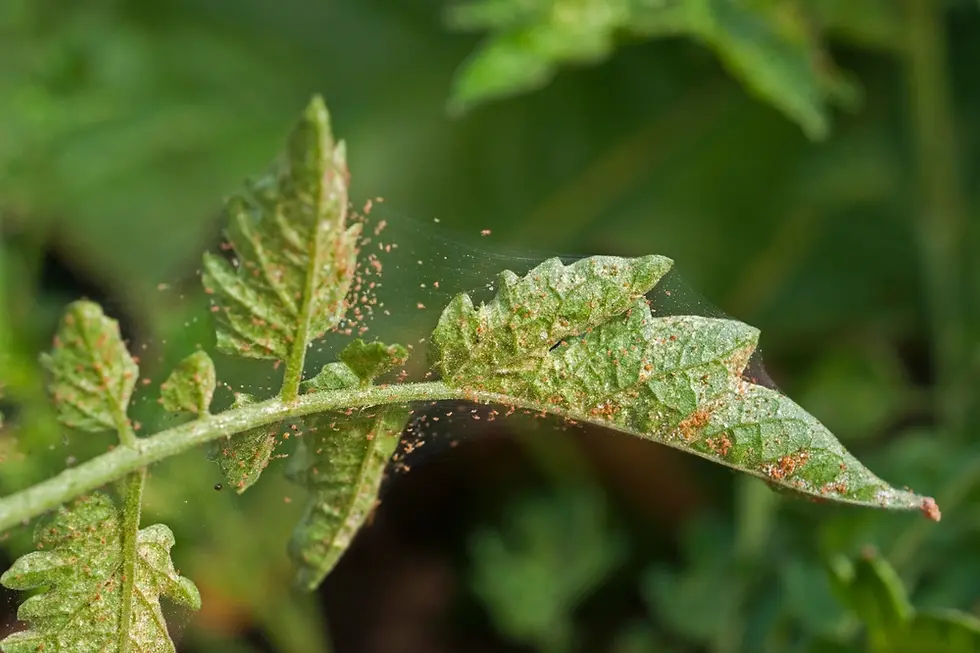Diatomaceous Earth for Spider Mites
- Andy Hemmer

- Feb 9, 2024
- 4 min read
Updated: Nov 7

Spider mites, those tiny arachnids that wreak havoc on plants, are every gardener's nightmare. Their rapid reproduction and voracious appetite for plant sap can decimate crops and ornamentals alike. While chemical pesticides offer a solution, they often come with harmful side effects. Enter diatomaceous earth (DE), a natural alternative gaining traction among gardeners worldwide. In this comprehensive guide, we'll delve into the life cycle and habits of spider mites, explore how diatomaceous earth combats them, and provide proactive strategies to minimize infestations.
Understanding the Life Cycle & Habits of Spider Mites

Life Cycle:
The life cycle of spider mites typically consists of four stages: egg, larva, nymph, and adult. Under optimal conditions, spider mites can complete their life cycle in as little as one week, allowing for rapid population growth. Female spider mites can lay hundreds of eggs during their lifespan, which can hatch within a few days, depending on environmental conditions such as temperature and humidity.
Habits:
Spider mites are most active during warm, dry weather, thriving in hot and dusty conditions. They feed by piercing plant tissues with their mouth parts and extracting the sap, which can lead to yellowing, wilting, and ultimately, the death of affected plant tissues. Spider mites natural ability to also produce fine silk webbing, which they use for protection and to facilitate their movement between plants.
Tips for Minimizing Infestations:
Prevention is key to managing spider mite infestations and to get rid of spider mites. Here's how to minimize their presence in your garden:
Maintain Optimal Growing Conditions: Spider mites thrive in hot, dry weather, so keep your garden adequately hydrated to deter infestations. Regular watering creates a less favorable environment for spider mites.
Practice Crop Rotation: Rotate crops each season to disrupt spider mites' life cycle and reduce soil buildup. This helps prevent recurring infestations and limits damage to plants.
Use Companion Planting: Incorporate spider mite-repelling companion plants like marigolds, garlic, and chives into your garden beds. This deters spider mites while attracting beneficial insects that prey on them.
Maintain Good Garden Hygiene: Remove debris, fallen leaves, and weeds to eliminate hiding places for spider mites. Prune and dispose of heavily infested plant parts promptly to prevent infestation spread.
Regular Monitoring: Inspect plants frequently for early signs of infestation, such as stippled leaves and webbing. Early detection allows for prompt intervention and prevents infestations from spiraling out of control.
Use a Natural Pesticide: Unlike chemical pesticides, Diatomaceous Earth poses no threat to pets or humans, making it a safe and Eco-friendly option for pest control. Diatomaceous earth (DE) is a natural, fossilized sedimentary rock with abrasive and absorbent properties. When applied to plants, DE's microscopic sharp edges pierce spider mites' exoskeletons, causing dehydration and death. Diatomaceous Earth can be used with neem oil and diatomaceous earth can also be applied wet by combing it with dish soap and water in a spray bottle.

How Diatomaceous Earth Works Against Spider Mites

The secret behind diatomaceous earth's effectiveness lies in its abrasive and absorbent properties. When applied to plants infested with spider mites, the microscopic sharp edges of DE particles pierce the mites' exoskeletons, causing them to dehydrate and die. Additionally, DE can absorb the lipids from the outer layer of the mites' bodies, further contributing to their demise. Unlike chemical pesticides, diatomaceous earth poses no threat to beneficial insects, pets, or humans, making it a safe and Eco-friendly option for pest control.
Using Diatomaceous Earth to Control Spider Mites
Here's a step-by-step guide on how to effectively use diatomaceous earth to combat spider mites in your garden:
Identify the Infestation: Inspect your plants regularly for signs of spider mite infestation, such as stippled leaves, webbing, and tiny moving specks on the undersides of leaves.
Choose the Right DE Product: Look for crawling insect control diatomaceous earth, which is safe for use around plants, pets, and humans. Avoid using pool-grade or filter-grade DE, as it contains higher levels of crystalline silica, which can be harmful if inhaled.
Apply DE to Affected Plants: Using a duster or a handheld sprayer, evenly coat the foliage of infested plants with a thin layer of diatomaceous earth. Be sure to cover the undersides of leaves where spider mites tend to congregate. You may also apply around the ground where your plant is growing as well as on top of the soil in potted plants. Nothing heavy, just a simple and even thin layer.
Reapply as Needed: DE loses its effectiveness when it becomes wet, so reapply it after rainfall or irrigation. Repeat the application every few days until the spider mite infestation is under control.
Monitor and Prevent: Continue to monitor your plants for any signs of spider mite resurgence, and take preventive measures such as regularly washing plant leaves and maintaining good garden hygiene to prevent future infestations.
Safety Precautions: While diatomaceous earth is generally considered safe for humans and pets, it is important to take some precautions when handling and applying it:
Wear a dust mask and gloves to avoid inhaling DE particles or getting them on your skin.
Apply DE on calm days to minimize the risk of inhaling airborne particles.
Store diatomaceous earth in a dry place away from moisture and humidity to prevent clumping.
Diatomaceous earth is a powerful, natural weapon for killing spider mites. Its abrasive and absorbent properties make it an effective and Eco-friendly alternative to chemical pesticides. By following the guidelines outlined in this comprehensive guide, you can safely and effectively control spider mite damage in your garden or indoor plants, allowing your plants to thrive and flourish once again.










Comments